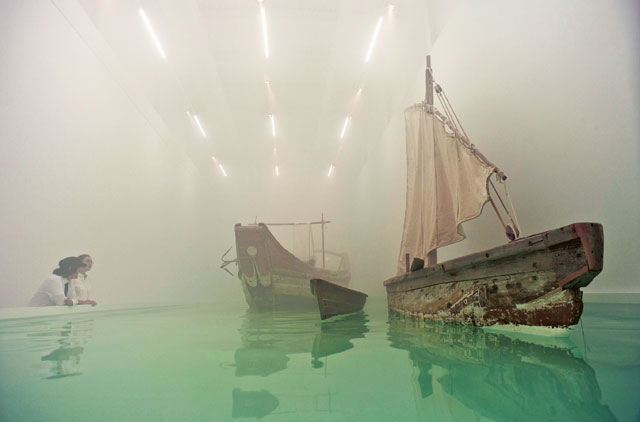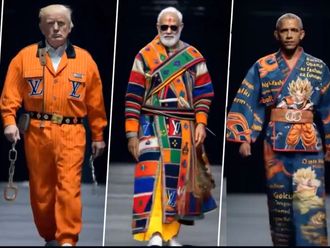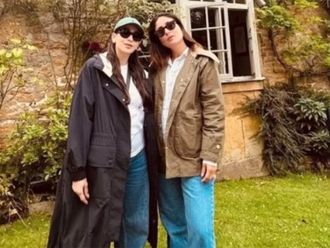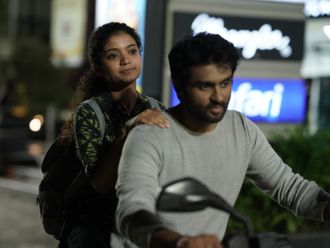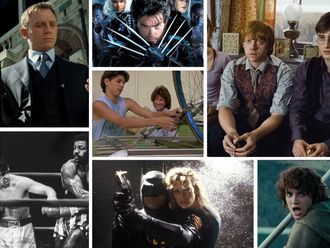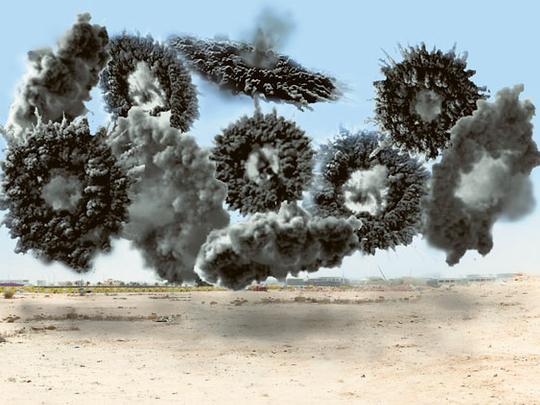
It has nothing to do with the fact that gunpowder was invented in China," Cai Guo-Qiang laughed, when asked about his fascination with the substance that he employed to spectacular effect in the Qatari capital last month. Speaking to Weekend Review in Doha, he said that he was "looking for a different method of artistic expression". "It was always easy to find gunpowder in my hometown; even my neighbours were making it. My personality is timid and cautious. I'm trying to liberate myself."
Cai's experiments with gunpowder have led him, over the years, to develop his signature "explosion events" — which he has held in places as diverse as a German military base and the Gobi Desert. Appointed director of visual and special effects for both the opening and closing ceremonies at Beijing Olympics in 2008, he startled the world with his pyrotechnics display.
Mathaf: Arab Museum of Modern Art is now displaying newly commissioned artworks by the Chinese contemporary artist, titled Cai Guo-Qiang: Saraab (Mirage). And Cai marked the opening of the exhibition with a bang — quite literally — through his Black Ceremony, which had onlookers at a site near Mathaf gaping in astonishment. The daytime explosions were conceived as "a spontaneous blossoming in the desert".
The exhibition at Mathaf offers Cai's perspective on the conceptual and material connections between China and the Arab world. Saraab features more than 50 works, including 16 newly commissioned pieces, 30 recent works and nine documentary videos. It showcases Cai's diverse body of work, ranging from his "gunpowder drawing" and large-scale site-specific installations to the explosion events.
Mathaf's goal is to provide an Arab perspective on modern and contemporary art. The 59,000-square-foot museum, located in a former school building in Doha, has a collection that makes for a rare comprehensive overview of modern Arab art.
The museum's director, Wassan Al Khudhairi, noted: "Mathaf seeks to shift perceptions and understanding of both Arab art and the larger context of modern and contemporary art from an Arab perspective, and Saraab is a wonderful opportunity to show the world the potential of this idea. Our goal is to build connections between discourses — in the Arab world, in the international art world, and now also within the greater history of Asia — and Saraab will be a seminal event for the museum."
Cai was born and raised in Quanzhou, in China's southern Fujian province. The city was once the starting point of the fabled Silk Route, and in the 13th and 14th centuries it became one of the world's largest seaports. A great number of Arab traders travelled to Quanzhou, many settling there for good. Over the years, the city also became home to many Muslim cemeteries.
"As a child, I used to ride my bike there in the evening with my friends … we enjoyed the mystical, exotic atmosphere there. This exhibition is a reminder that I ought to try to understand what is written on these tombstones in ancient Arabic," said Cai, referring to inscriptions of verses from the Quran and Hadith expressing sentiments towards life and the afterlife. "Many of them address death directly. This direct way in which they approach death left a deep impression on me. Only now I understand what the text on the tombstones means. All that lives will die, all will have a taste of death. That is what was so different. For the Chinese, even when they are buried, there is no mention of death."
Cai said he had researched Islamic culture in different regions, as it encompasses many different nationalities. "The more you study, the more mysterious it is."
Cai gets emotional while reflecting on a childhood when he had a "relationship" with Islamic culture. For him, the starting point is his homeland — whether it is the delicately crafted doors in narrow alleys or the headscarf worn by his grandmother. "Though I've worked throughout the world, my heart is still in my hometown. For an artist, no matter where he lives, his heart is always in his homeland. He is always a foreigner. This exhibition for me is a spiritual homecoming."
Asked why he didn't begin in the Xinxiang region of China, which has a majority Muslim population, he said: "When I was young, I travelled to Xinxiang with my wife. It was part of my initiation into Islamic culture."
One of the exhibits at Saraab, an installation called Homecoming, depicts in stone and incised calligraphy the Muslim community of Quanzhou. Cai wanted to "bring back home" those who had died abroad. The rocks brought for the exhibit reverse the route taken by Arab traders, who died in China. These rocks were sourced and inscribed in Quanzhou, and shipped to Doha.
A similar theme is to be found in the installation titled Endless, which shows three boats bobbing in water engulfed by mist. The wood they are made from recalls the boat-building traditions of the past both in the Arabian Gulf and in China. The physical experience thus created is ambiguous — of neither travel nor stasis.
The exhibit Flying Together, showing falcons and a camel, may signify the Arab world, or allow the viewer to come to his own conclusion. It can, for instance, be interpreted as falcons attacking the camel, or flying it to safety. "Both these animals are very common symbols of the Arabian Gulf. Are they helping the camel fly, or are they attacking it? I want the viewer to explore what the action means," Cai told Weekend Review.
Route, meanwhile, retraces the maritime Silk Route between China and the Arabian Gulf, across a large map resembling an old seafaring chart. The artwork has been drawn with gunpowder and exploded on to paper. It is one among many gunpowder drawings at the exhibition.
Each of the new works "explores a set of possible connections that simultaneously allow freedom for the audience to interpret at a personal level".
About Cai Guo-Qiang
Cai Guo-Qiang was born in 1957 in Quanzhou, Fujian province, China, and was trained in stage design at the Shanghai Theatre Academy. His work has since spanned multiple mediums within art, including drawing, installation, video and performance art. While living in Japan from 1986 to 1995, he explored the properties of gunpowder in his drawings, an inquiry that eventually led to his experimentation with explosives on a massive scale and to the development of his signature explosion events. Drawing upon Eastern philosophy and contemporary social issues as a conceptual basis, these projects and events aim to establish an exchange between viewers and the larger universe around them utilising a site-specific approach to culture and history. Cai was awarded the Golden Lion at the 48th Venice Biennale in 1999, the 7th Hiroshima Art Prize in 2007, and the 20th Fukuoka Asian Culture Prize in 2009. He was director of visual and special effects for the opening and closing ceremonies of the 2008 Summer Olympics in Beijing. In 2008, he was the subject of a retrospective at the Solomon R. Guggenheim Museum, New York. In fall 2010, Cai created ‘Odyssey' for the Museum of Fine Arts Houston. Installed as part of the museum's ongoing ‘Portal Project', it is one of his largest gunpowder drawings to date. He lives and works in New York.
Cai Guo-Qiang: Saraab will go on until May 26 at Mathaf: Arab Museum of Modern Art in Doha, Qatar.


